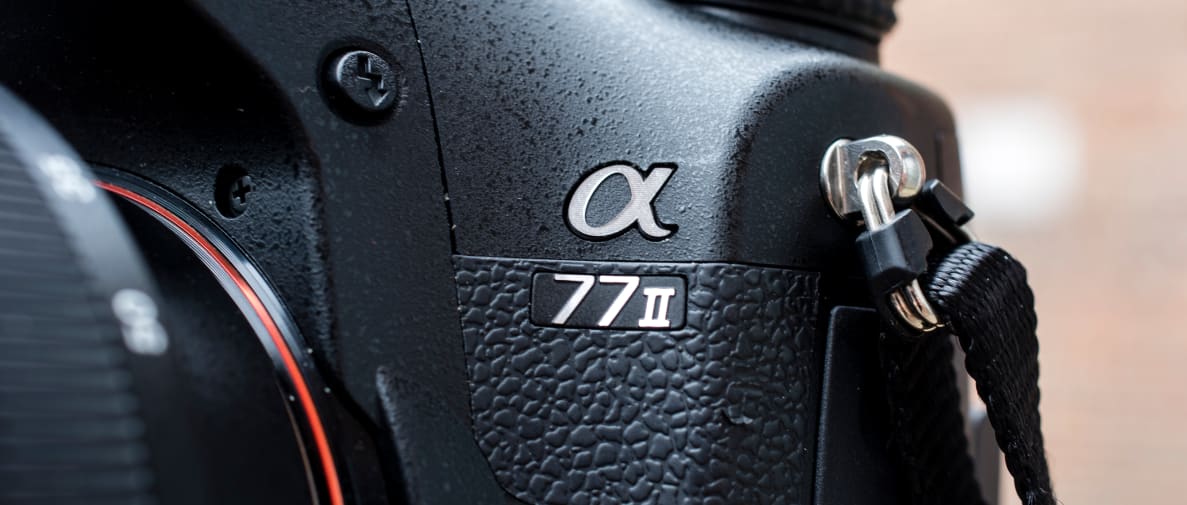This time around, Sony is turning its attention back to the more traditional DSLR segment, issuing a follow-up to its three-year-old A77. The new camera, the Sony A77 II (MSRP $1,199) is a more flexible camera designed to compete with the Nikon D7100 and the Canon EOS 70D. It's the company's flagship APS-C camera and, as you'd expect from a top-of-the-line model, is packed to the gills with hardware and software features.
The differences from the A77 aren't major—ISO sensitivity has been expanded, the display has been upgraded, and the sensor/processor has seen the expected spec bump—but it adds up to a heck of a nice camera. And with a debut MSRP of just $1,200, it hits the market at a very attractive price that should put its competitors at Canon, Nikon, and Pentax on notice.
Design & Handling
Chunky Monkey
The Sony A77 II is not a light camera by any means. Weighing in at 1 pound, 9.6 oz the camera body itself is big enough. Add on the 16-50mm f/2.8 lens and its additional 1 lb, 3 oz and you get a combined weight of nearly 3 pounds—before you consider adding on extra accessories. If you're stepping up from a mirrorless camera or—more dramatically—a smartphone, it's going to feel completely foreign. I've shot with pro-grade cameras throughout my career and enjoy the extra heft, but it's something for newbies to be aware of. With all that bulk, however, you get a sturdy, well-built camera with dust and moisture sealing that will allow you to keep shooting even when the weather gets rough. It feels heavy when you lift it, but the grip is designed well enough that even long shooting sessions don't result in much fatigue.
{{ photo_gallery name="Tour" }}
One of the best-design features of the A77 II is the rear monitor. With more moves than a Bop It, you can flip it, tilt it, twist it, turn it—whatever else you can think of. We tried to find a shooting angle that you couldn't see the rear screen with and we simply couldn't. This means you can take selfies with the screen on top or bottom, shoot well above your head, and can even shoot around corners. Needless to say, we had a lot of fun with this...
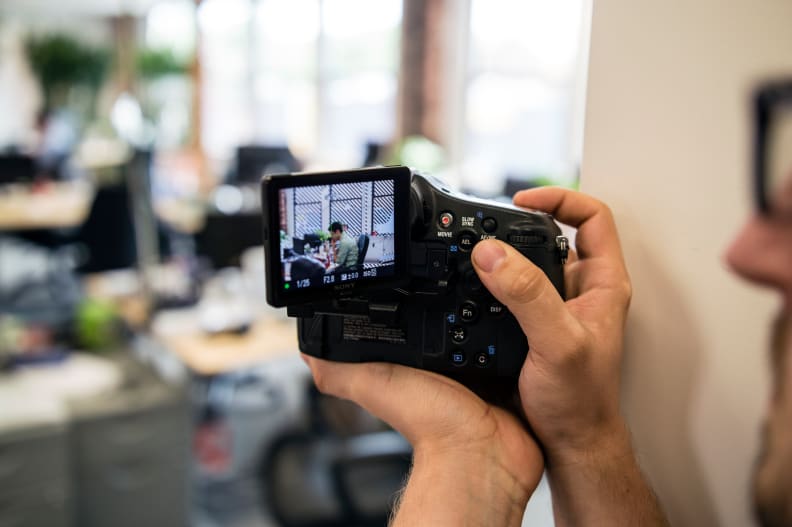
We had a lot of fun with the "corner shot".
If it's buttons you are looking for, it's buttons you'll find. The A77 II has a plethora of physical controls including "function" and "custom" buttons that you can designate. White balance, ISO, focus mode, exposure compensation, and drive mode all have a dedicated buttons as well, each saving you a trip to the menu. The controls are all laid out logically, though our biggest complaint is the left-side placement of the menu button and mode dial. You don't frequently change modes or jump into the menu, but when you do you have to pull your hand away from supporting the body.
In our time with the A77 II, we did run into a few problems, however. One of the big issues was with focus accuracy. While the 79-point phase-detect AF system is extremely robust, it sometimes missed the mark. It was extremely fast and smooth, but not always on target, which resulted in some bad shots due to missed focus. The camera also tended to underexpose scenes by about a half-stop for whatever reason. This is easy to compensate for, but if going off the digital meter, it could be a bit off. If you account for those issues, however, the A77 II is as pleasing to shoot with as any other high-end APS-C model on the market.
Performance
Fast, sharp, and ....
Both in the lab and out in the real world, the A77 II lived up to our lofty expectations. It performed well on nearly all of our lab tests and wasn't nearly as temperamental in the lab as some entry-level cameras we've tested recently. For starters, the A77 II very accurately reproduces colors in normal lighting conditions. The A77 II has five color modes–Standard, Vivid, Neutral, Portrait, and Landscape. Of these, Standard came out as the most accurate, with a reasonable saturation level of 103.2%. Vivid boosted saturation up to over 120% and Neutral brought it down to 83.3%, giving you easy options for both desaturation and color boosting right on the camera.
{{ photo_gallery name="Sample" }}
While color accuracy is nice, a camera like this needs to really shine in low light. The A77 II accomplishes this with an ISO range of 50–25,600, most of which are usable for any purpose. While shooting from ISO 50-800 you barely notice any noise in the final shot, even when pixel peeping at 100%. Beyond there things get a little dicey; you can shoot up to ISO 3200 without crossing a 2% noise ratio, but we recommend capping it at ISO 1600 if you want to preserve fine details. If you take a look at the chart below you can see how you start to lose those fine details once you float above ISO 1600.
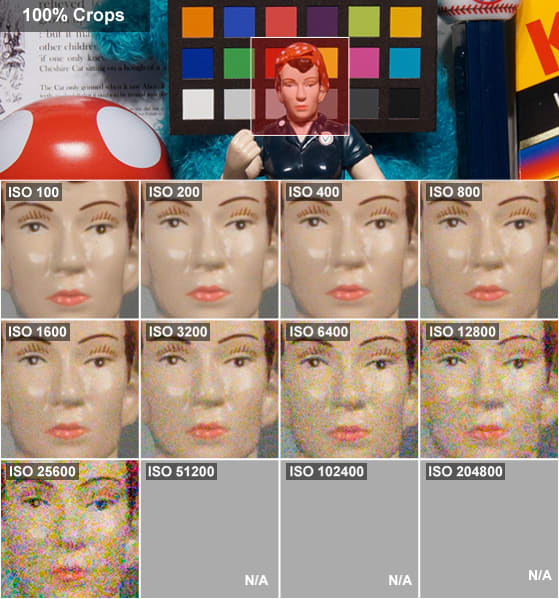
Like other DSLRs, the Sony A77 II includes a mirror between the lens and the sensor. Unlike a traditional DSLR, this mirror isn't used to feed the image to an optical viewfinder. Instead, it's translucent, allowing nearly all of the incoming light to pass onto the sensor itself. This translucent mirror diverts some light to the camera's autofocus sensor, using the rest for capturing the image. While this does cut some light out from the final exposure, it allows the camera to shoot without having to move the mirror at all. Since it doesn't have to slap a mirror around every time it takes a photo, the A77 II can fire continuously at up to 12 frames per second—without putting much wear and tear on the camera itself. There is some evidence that these translucent mirrors limit dynamic range a bit, but we saw no issues there as the A77 II easily topped 12 stops of range at base ISO.
The A77 II makes use of that mirror primarily when shooting stills and using its 79-point phase-detect AF system. That's more points than any other dedicated AF sensor on the market (some on-sensor PDAF units have more), with 15 cross-type sensitive points letting you focus accurately at apertures as wide as f/2.8. The A77 II pairs all those points with a flexible AF system that lets you set the tracking sensitivity, using a fixed AF point while also tracking if the subject moves to any of the adjacent points. It's similar to the new "Group AF" option on the Nikon D4S, though it falls behind the focus flexibility found on Canon's EOS 1D X. Given that those are the two premier sports-shooting DSLRs on the market, the A77 II is in some fine company.
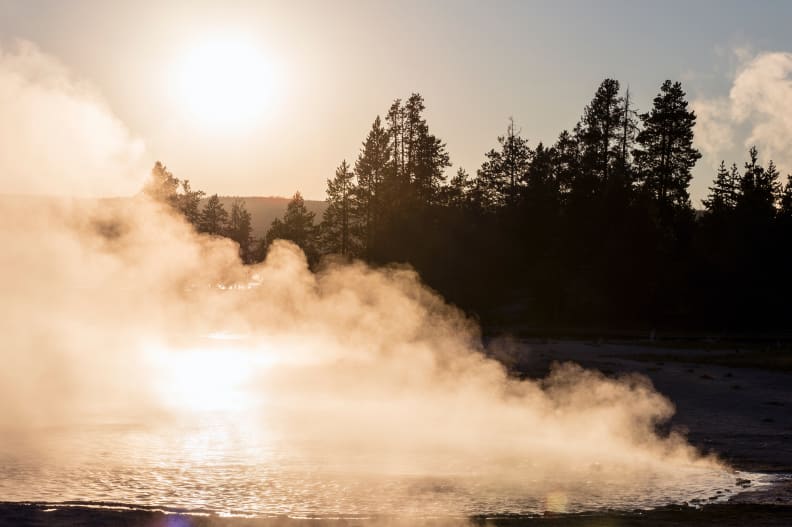
Of course no camera these days can get by without also including excellent video capability. The A77 II does well here, with very sharp results when using the Sony 16-50mm f/2.8 lens that is "kitted" along with the camera. When capturing HD video we achieved around 750 line pairs per picture height horizontally and 725 LP/PH vertically. This is almost on par with the more expensive Sony A7S–which shoots fantastic HD video, costs about twice as much, and yet only resolved around 25 lw/ph more at MTF50. Even in low light the A77 II saw very little drop in sharpness, with results that are comparable to bright light results on most DSLRs. Unsurprisingly, this low light quality also extended to our low light sensitivity test. Though the resulting video is grainy, we were able to get an acceptably bright image (>50 IRE) with the light level below 1 lux.
Features
Par for Sony's course
The A77 II has all the features that we have come to expect from Sony, such as picture effects and scene modes. Even in its high-end cameras, Sony always includes these extras to appeal to shooters of any level. The A77 II includes these, and it also offers plenty of wireless connectivity via NFC and WiFi. Sony’s offers a free application called "PlayMemories Mobile" that, though questionably implemented, lets you easily share shots from the camera to your smartphone no matter where you are.
The "Smile Shutter" technology is something that is becoming a staple in all cameras, and Sony did not overlook adding it here. It works well in tandem with the flexibility of the rear monitor. Since I covered the rear monitors flexibility in the design section, I will save you a reread and won't go into detail again–just know it is handy for selfies or times when you're framing with the camera at a tough angle.
The A77 II has a fantastic electronic viewfinder (EVF), which has advantages and disadvantages compared to the optical finders found on both the Canon and Nikon competitors. On the negative side you're only seeing the image from the sensor as opposed to in real time through the lens. On the positive side, you can see what your scene actually looks like while you're shooting, you get instant review and real-time shooting info without taking your eye off the finder, and you can use the finder while recording video.
You can also use the EVF while manually focusing with the camera's focus peaking feature. The manual focus features complement the autofocus very well, giving you options regardless of what light level or subject you're dealing with. Plus, add the focus speed to the A77 II's continuous shooting chops and you have one of the best action-shooting DSLRs on the market, available for under $1,500.
{{ photo_gallery name="Design" }}
Another neat feature that the A77 II has is the "Auto High Dynamic Range" setting. Though other cameras include similar modes, we really like the results from the A77 II. It produces a pleasingly graded, flat image that has extended range without looking overly processed. You can have it apply to a single photo with the "D-Range Optimizer" or choose the exposure intervals and it will quickly bracket while snapping all the photos needed and then combine them in-camera for an HDR photo. If we have one complaint it's that this feature isn't brought through to all of the shooting modes, shattering our dreams of taking (subtle!) HDR panoramas right in the camera.
Conclusion
A solid update at a good price that will give the competitors a run for their money.
Even with body-only sale prices sure to dive to sub-$1,000 levels soon, the Sony A77 II is aimed squarely at the "prosumer" market. It does a good job of implementing features that fulfill the wide range of needs for advanced shooters but doesn't leave you entirely to your own devices the way the top-end Canon and Nikons do. You have plenty of options and control for someone looking for it, but it can be turned on "easy mode" for a new shooter as well. It is a good camera choice for someone looking to get into a pro style setup, but isn't quite ready to go full-frame.
At a glance the A77 II looks almost identical to the A77 due to the consistency in design. However, with all the upgrades to the rear monitor and expanded ISO range, the A77 II is simply a better camera than its predecessor. It's also being launched at a much lower price–$1,199 for body only, $1,699.99 with the 16-50mm f/2.8 kit lens we tested it with. Consider that the original A77 launched for $1,999 with the same lens just a couple of years ago and you'll see how competitive this part of the market has gotten. If you are on a tight budget–and don't need any of the bells and whistles of the A77 II–the A77 can still be picked up with the same 16-50mm f/2.8 lens for $1,399 on Amazon. That said, we think the extra cash is worth spending to get the newer version, as it's a more flexible, better-performing camera.
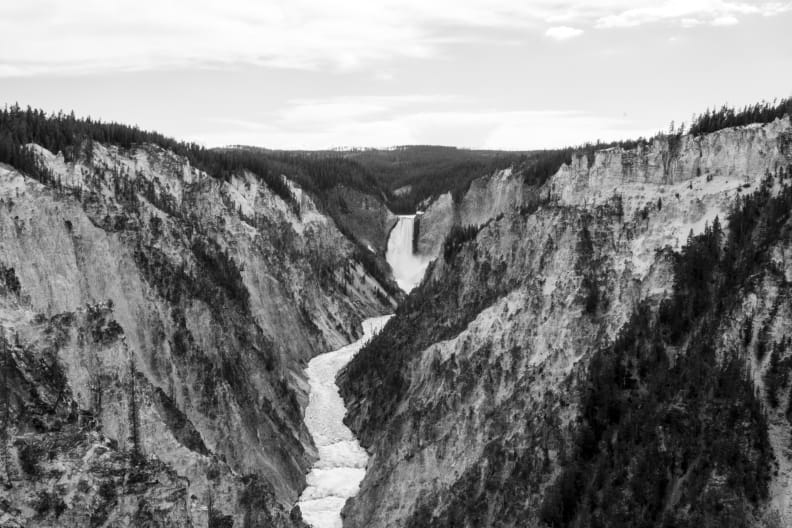
As far as other cameras in its class, the Canon EOS 70D, Nikon D7100, and the Pentax K-3 are all in the same ballpark with both performance and price. The Canon gives you the excellent Dual Pixel AF for smooth continuous focus while capturing video, the Nikon captures the best all-around video and is compatible with any F-mount lens from the past 60 years, and the K-3 is one of our favorite still cameras. The A77 II is a fantastic alternative, however, with faster continuous shooting speed, more reliable autofocus, an excellent EVF, and a good mix of video and still performance.
Though we think the A77 II is the best all-around option of the bunch, you can make a compelling case for all four cameras. If you shoot a lot of video and don't need a mic jack, the Canon 70D's Dual Pixel AF can't be beat. If you are focused entirely on stills and want a camera that can take a beating, the K-3 is your best bet. If you want to use legacy lenses and do a little bit of everything, the Nikon D7100 is a fine choice. But if you like to capture action, want the most robust action-oriented focus system of the group, and like a good mix of manual control and creative extras, the Sony A77 II is simply the best in this class right now.
We want to thank Chris Snow for taking the Sony A77M2 on his trip to Yellowstone National Park and capturing these stunning sample photos.
By the Numbers
So now's about the time where we get into the nitty gritty details of performance, and on the whole: this is a respectable DSLR. Though it's a chunky monkey, this camera posts some impressive measurables overall, with very few sore spots. It is in a competitive space in the market, contending with the Canon EOS 70D, Nikon D7100, and Pentax K-3, not to mention a host of new high-end mirrorless cameras. The A77 II holds its own, though, with a little bit of something for everyone.
Color & White Balance
Beyond the Mendoza Line
The A77 II isn't the most color-accurate shooter out there, but it does well enough to stave off our griping. Posting a ∆C 00 saturation error of 2.63 and an overall saturation of 103.2%, you can expect fairly accurate shots. Like I said in the full review: not great, but not bad either.
It should be pointed out that this is only for the Standard color mode, and you'll obviously get varying results if you flip through the others. Vivid color mode dramatically oversaturates your shots and so on.
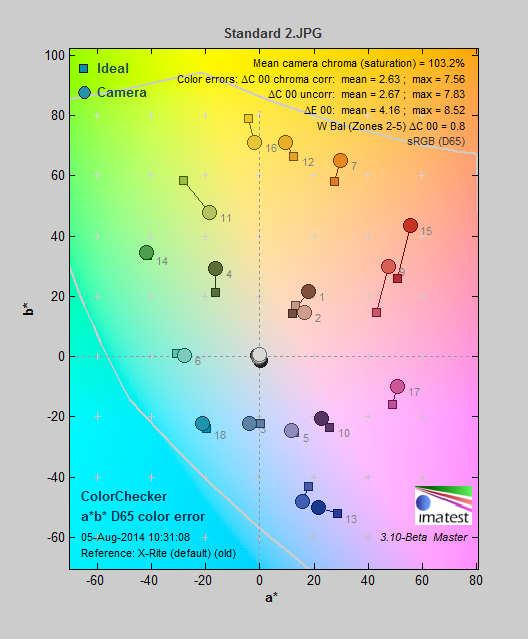
The A77M2 posted acceptable result, but lower than what we expected from a high-end camera.
White balance is also decent—even when set to auto, it follows the change in lighting conditions well. Even in incandescent light, you can expect that your JPEGs will be within 1000 kelvin of where they should be—and near-perfect in daylight. Obviously, if you shoot in RAW you can sidestep most of this, but it's good to know that you're covered in any situation.
Sharpness
Telephoto or bust
First the good news: the 16-50mm f/2.8 kit lens is a monster, and allows for tack-sharp shots. There's a little bit of softening around the edges at wider apertures, but for the most part there isn't noticeable coma or chromatic aberration.
You may also notice that images are a tad sharper if you stop the aperture down a bit, but this is a fairly common theme for lenses. It's really not that big of an issue given that sharpness consistently pushes 2000 lw/ph at every focal length and aperture setting. The beauty of an interchangeable-lens camera is that you can pick up new glass if you're unsatisfied with the kit option.
It's not uncommon for some kit lenses to show some minor issues at full wide, and here too that's the case. Though the 16-50mm f/2.8 kit option is tack-sharp all the way through the range of focal lengths, it does show just over 3% barrel distortion when zoomed all the way out.
Noise
Not the good kind
If there's one sore spot to pick out on the Sony A77 II's overall performance, it's noise. Though the DSLR does a great job at keeping a lid on it until ISO 3200, you're going to want to have some sort of reduction enabled. Otherwise: you're in for some strange artifacting in shots.
Without NR enabled, we saw shots taken at ISO 3200 and above cross past 2%, and wind up at 4.61% at ISO 25600. It's not unexpected with a crop sensor, but it's still annoying when you have to shoot in low light.

Considering that even the highest noise reduction setting doesn't rip out too much detail from backgrounds, you may find yourself using it in situations where fine detail and high-frequency patterns are unlikely. It's a good setting to leave on for most shooters.
Video
Insert the last word of the CSI: Miami opener here
If you want a DSLR that can also shoot cinema, this is an option that won't leave you high and dry. Performance here—both observed and measured—was very impressive.
First off: never fear when it comes to low light. In our labs, the camera was able to capture an image above 50 IRE until somewhere between 0 and 1 lux. That's fantastic for an APS-C sensor. Granted, video is a bit noisy at that light level, but it's still a great cabability to have.
Motion is good, but not perfect.
In bright light, the A77 II handles sharpness well in video—as it does for stills. Boasting sharpness results of 750 lp/ph horizontally and 725 lp/ph vertically, this camera is no slouch when it comes to sharp videography.
In low light, very little sharpness is sacrificed, as those numbers drop to 700 and 675, respectively. Again, crazy-good performance from a similarly insane crop sensor.
Meet the tester
As a photojournalist, Jackson has had stints working with bands, the military, and professional baseball teams before landing with Reviewed. Outside of Reviewed, he can be found looking for the next game to relieve his "Gamer ADD" or growing his beard.
Checking our work.
Our team is here to help you buy the best stuff and love what you own. Our writers, editors, and experts obsess over the products we cover to make sure you're confident and satisfied. Have a different opinion about something we recommend? Email us and we'll compare notes.
Shoot us an email
